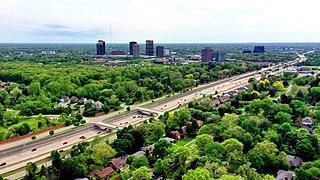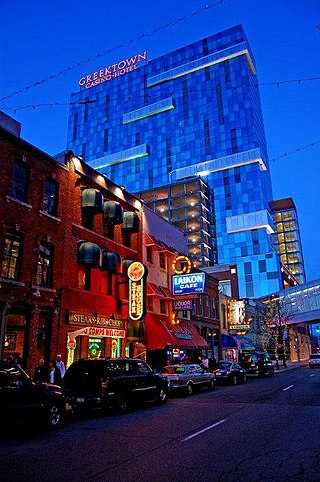Related Research Articles

Wayne County is the most populous county in the U.S. state of Michigan. As of 2020, the United States Census placed its population at 1,793,561, making it the 19th-most populous county in the United States. The county seat is Detroit. The county was founded in 1796 and organized in 1815. Wayne County is included in the Detroit-Warren-Dearborn, MI Metropolitan Statistical Area. It is one of several U.S. counties named after Revolutionary War-era general Anthony Wayne.

Oakland County is a county in the U.S. state of Michigan. It is part of the metropolitan Detroit area, located northwest of the city. As of the 2020 Census, its population was 1,274,395, making it the second-most populous county in Michigan, behind neighboring Wayne County. It is the largest county in the United States without a city of 100,000 residents. The county seat is Pontiac. The county was founded in 1819 and organized in 1820.

Macomb County is a county located in the eastern portion of the U.S. state of Michigan, bordering Lake St. Clair, and is part of northern Metro Detroit. As of the 2020 Census, the population was 881,217, making it the third-most populous county in the state. The county seat is Mt. Clemens. Macomb County is part of the Detroit-Warren-Dearborn, MI Metropolitan Statistical Area. The city of Detroit is located south of the county's southern border. Macomb County contains 27 cities, townships and villages, including three of the top ten most-populous municipalities in Michigan as of the 2010 census: Warren (#3), Sterling Heights (#4) and Clinton Township (#10). Most of this population is concentrated south of Hall Road (M-59), one of the county's main thoroughfares.

Clinton Township, officially the Charter Township of Clinton, is a charter township of Macomb County in the U.S. state of Michigan. As of the 2020 census, the township had a total population of 100,513. It ranks as Michigan's most-populated township and 8th most-populated municipality overall.

Metro Detroit is a major metropolitan area in the U.S. state of Michigan, consisting of the city of Detroit and over 200 municipalities in the surrounding area. There are varied definitions of the area, including the official statistical areas designated by the Office of Management and Budget, a federal agency of the United States.

The New Mt. Moriah Baptist Church is located at 13100 Woodward Avenue in Highland Park, Michigan in Metro Detroit. It was built in 1922 as the Trinity United Methodist Church, in the Gothic Revival style. It was listed on the National Register of Historic Places in 1982.
Carlo Alfred Romanelli (1872–1947) was an Italian sculptor, born in Florence, Italy August 24, 1872 and died August 9, 1947. He came to the United States in 1902, settling in Los Angeles, California. He moved to Detroit, Michigan in the early 1920s. He was the son of Italian sculptor Raffaello Romanelli (1856–1928) who created the 1927 bust of Dante Alighieri on Belle Isle Park in Detroit. Among Carlo Romanelli's Detroit works are the bronze tablet of Cadillac's landing, now at the Cadillac Center People Mover Station downtown, and La Pieta at the entrance of Mt. Elliott Cemetery. Carlo attended the Royal Academy of Art in Italy and studied with his father and sculptor Augusto Rivalta; Rivalta's Detroit statue of Christopher Columbus (1910) is now at Jefferson Avenue and Randolph Street.

In 2004, Metro Detroit had one of the largest settlements of Middle Eastern people, including Arabs and Chaldo-Assyrians in the United States. As of 2007 about 300,000 people in Southeast Michigan traced their descent from the Middle East. Dearborn's sizeable Arab community consists largely of Lebanese people who immigrated for jobs in the auto industry in the 1920s, and of more recent Yemenis and Iraqis. In 2010 the four Metro Detroit counties had at least 200,000 people of Middle Eastern origin, excluding Jews. Bobby Ghosh of TIME said that some estimates gave much larger numbers. From 1990 to 2000 the percentage of people speaking Arabic in the home increased by 106% in Wayne County, 99.5% in Macomb County, and 41% in Oakland County.
Jews have been living in Metro Detroit since it was first founded, and have been prominent in all parts of life in the city. The city has a rich Jewish history, but the Jewish community has also seen tensions and faced anti-Jewish backlash. Today, the Jewish community is quite established and has a number of community organizations and institutions.

Black Detroiters are black or African American residents of Detroit. According to the U.S. Census Bureau, Black or African Americans living in Detroit accounted for 79.1% of the total population, or approximately 532,425 people as of 2017 estimates. According to the 2000 U.S. Census, of all U.S. cities with 100,000 or more people, Detroit had the second-highest percentage of Black people.
As of 2002, ethnic Chinese and Chinese American people comprise the second-largest Asian-origin ethnic group in the Wayne–Macomb–Oakland tri-county area in Metro Detroit. As of that year there were 16,829 ethnic Chinese, concentrated mainly in Troy, Rochester Hills, and Canton Township. As of 2012, Madison Heights also hosts a significant Chinese community.
The Hungarian people and Hungarian Americans immigrated to Metro Detroit in the 20th century. Historically they populated Delray in Detroit but moved to the Downriver area in the 1960s. There were four historic waves of Hungarian immigration to Detroit.

As of 2001, the Metro Detroit area had the U.S.'s second largest Polish ethnic concentration after Chicago. As a whole, Michigan has the second-largest percentage of Polish ancestry of any U.S. state.
A 2013 report by the Global Detroit and Data Driven Detroit stated that of the immigrant ethnic groups to Metro Detroit, the largest segment is the Indian population. As of 2012, the Indian populations of Farmington Hills and Troy are among the twenty largest Indian communities in the United States. As of the 2000 U.S. Census there were 39,527 people with origins from post-partition India in Metro Detroit, making them the largest Asian ethnic group in the Wayne County-Macomb County-Oakland County tri-county area. People of those origins are found throughout Metro Detroit, with the majority being in Oakland County.
In 2004 58.5% of the people of Hispanic origin in the Wayne County-Macomb County-Oakland County tri-county area were Mexicans.

As of 1999 120,000 people in Metro Detroit indicated they are of Greek descent. Stavros K. Frangos, author of Greeks in Michigan, stated "From the 1890s to the present all available sources agree that" about one third of Michigan's Greek Americans live in Metro Detroit.

Metro Detroit has the following ethnic groups:
The organization Global Detroit stated that the largest group of ethnic Albanians not in Europe is in Metro Detroit. As of 2014, 4,800 ethnic Albanians live in Macomb County, making up the fourth-largest ethnic group in that county, and the highest concentration of Albanians in Metro Detroit.
The Italian Tribune is a newspaper first published in Detroit, Michigan on May 1, 1909 as La Tribuna Italiana del Michigan. It was founded by Vincent Giuliano, with the help of his wife, Maria Giuliano. Vincent had been publishing a newspaper in Chicago for the Italian textile workers when a group of auto workers in Detroit asked him to start a similar paper in Detroit to bring the community together.
References
Notes
- 1 2 3 4 5 Delicato, p. 7.
- 1 2 Woodford, p. 186.
- 1 2 Delicato, p. 8.
- 1 2 Babson, p. 28.
- ↑ Babson, p. 27.
- ↑ Conway, J. and D. F. Jamroz (2007). Detroit's Historic Fort Wayne. Arcadia Publishing. ISBN 978-0-7385-5112-8.
- ↑ Mayer, p. 28.
- 1 2 3 Mayer, p. 29. "Two Italian newspapers published in the city are the "La Voce del Popolo"[...]"
- ↑ Michigan History Magazine, Volumes 21-23, p. 158. "Three Italian newspapers are published in Detroit — La Voce del Popolo, at 3442 McDougall Avenue, La Tribuna Italiana d' America, at 2751 East Jefferson Avenue, and L'Avvenire at 3826 McDougall Avenue. La Voce del Popolo maintains[...]"
- 1 2 Feinstein, p. 224. "Three Italian newspapers are published in Detroit — La Voce del Popolo, at 3442 McDougall Avenue, La Tribuna Italiana d' America, at 2751 East Jefferson Avenue, and L'Avvenire at 5826 McDougall Avenue. La Voce del Popolo maintains an independent point of view and is said to be the only Italian paper carrying on a campaign against the underworld. In general, it publishes European views and reports on affairs in Italy and the United States. La Tribuna, which ds [1934] very favorable to the Fascist regime in Italy, encourages organization among Detroit Italians in order that they may have more voice in political matters. L'Avvenire is devoted to local politics and also urges the organization of Italians into a compact political group."
- ↑ "Edward Baker, Clinton Township: Publisher of Italian Tribune weekly." (obituary) The Detroit News . July 23, 2004. Retrieved on December 5, 2013. ID: det19387044.
- ↑ "Contact Us." (Archive) Italian American Cultural Society. Retrieved on December 5, 2013. "Address Italian American Cultural Society 43843 Romeo Plank Road Clinton Township, MI 48038"
- 1 2 Kucharski, Chris. "CLINTON TWP. ITALIAN CULTURAL SOCIETY CELEBRATES 50 YEARS." Detroit Free Press . November 4, 2007. Community Free Press p. CU2. Retrieved on December 5, 2013.
- ↑ "Cultural center takes root in Clinton Township." The Detroit News . December 8, 2004. ID: det20402745. Retrieved on December 5, 2013.
- ↑ "Cultural center keeps name." The Detroit News . October 23, 2005. ID: det22663911. Retrieved on December 5, 2013.
- 1 2 3 4 Babson, p. 45.
- ↑ "Welcome to the web site of the Consulate of Italy in Detroit." Consulate of Italy in Detroit . Retrieved on February 1, 2009.
- ↑ Feinstein, p. 5.
Citations
- Babson, Steve. Working Detroit: The Making of a Union Town. Wayne State University Press, 1986. ISBN 0814318193, 9780814318195
- Delicato, Armando. Italians in Detroit (Images of America: a history of American life in images and texts). Arcadia Publishing, 2005. ISBN 0738539856, 9780738539850.
- Feinstein, Otto. Ethnic Communities of Greater Detroit. Monteith College, Wayne State University, 1970.
- Mayer, Albert. Ethnic groups in Detroit, 1951. Wayne University Department of Sociology and Anthropology, 1951.
- Content re-posted to: Feinstein, Otto. Ethnic Communities of Greater Detroit. Monteith College, Wayne State University, 1970.
- Michigan History Magazine, Volumes 21-23. Michigan Historical Commission, 1937. (content seems to also be present in Feinstein)
- Content also in: Fuller, George Newman and Lewis Beeson. Michigan History, Volume 23. Michigan Department of State, 1939.